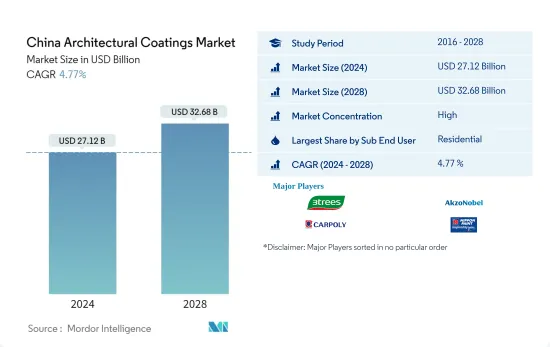 |
市场调查报告书
商品编码
1683768
中国建筑涂料:市场占有率分析、产业趋势与统计、成长预测(2025-2030 年)China Architectural Coatings - Market Share Analysis, Industry Trends & Statistics, Growth Forecasts (2025 - 2030) |
||||||
价格
※ 本网页内容可能与最新版本有所差异。详细情况请与我们联繫。
简介目录
预计 2024 年中国建筑涂料市场规模为 271.2 亿美元,预计到 2028 年将达到 326.8 亿美元,预测期内(2024-2028 年)的复合年增长率为 4.77%。

主要亮点
- 最大的终端用户群:住宅:由于对住宅领域的持续投资以及世界上最大的人口,住宅领域占据了建筑涂料消费的大部分。
- 按技术分類的最大市场细分:水性涂料:由于中国政府将于 2020 年推出严格的建筑涂料 VOC 法规,水性涂料将占据主要份额。
- 按树脂分類的最大细分市场:丙烯酸:由于水性涂料的成长,丙烯酸涂料是该国最大的水性耐腐蚀树脂,其次是 PVA,因此是最大且成长最快的细分市场。
中国建筑涂料市场趋势
按终端用户细分,住宅是最大的。
- 受2015年以来长期復苏以及2017与前一年同期比较住宅投资年增9.4%的推动,2017年中国建筑涂料消费量达到峰值,与前一年同期比较增7.80%。此外,2017年总占地面积占地面积与前一年同期比较%,而住宅建筑销售占地面积较去年同期成长5.3%。
- 2020年,新冠疫情的蔓延导致新建住宅和商业建筑减少,从而导致建筑涂料消费低迷,但由于竣工量增加以及2020年流行的DIY建筑增加,建筑涂料消费将在2021年復苏。
- 政府的倡议,例如从 2022 年 3 月起取消进口油漆和涂料的申请和测试要求,预计将增强涂料公司对该国建筑涂料未来前景的信心,从而导致预测期内消费和销售增加。
中国建筑涂料产业概况
中国建筑涂料市场较为分散,前五大企业的市占率为20.63%。该市场的主要企业是:3TREESGROUP、AkzoNobel NV、CARPOLY、Nippon Paint Holdings 和 PPG Industries, Inc.(按字母顺序排列)。
其他福利
- Excel 格式的市场预测 (ME) 表
- 3 个月的分析师支持
目录
第 1 章执行摘要和主要发现
第 2 章 简介
- 研究假设和市场定义
- 研究范围
- 调查方法
第三章 产业主要趋势
- 占地面积趋势
- 法律规范
- 价值链与通路分析
第 4 章 市场细分
- 次级终端用户
- 商业的
- 住宅
- 科技
- 溶剂型
- 水性
- 树脂
- 丙烯酸纤维
- 醇酸
- 环氧树脂
- 聚酯纤维
- 聚氨酯
- 其他树脂类型
第五章 竞争格局
- 重大策略倡议
- 市场占有率分析
- 业务状况
- 公司简介
- 3TREESGROUP
- AkzoNobel NV
- Axalta Coating Systems
- CARPOLY
- DAI NIPPON TORYO CO.,LTD.
- Flugger group A/S
- Foshan Caboli Painting Material Co.,Ltd.
- Guangdong Maydos building materials limited company
- Hempel A/S
- Jotun
- Kansai Paint Co.,Ltd.
- Nippon Paint Holdings Co., Ltd.
- PPG Industries, Inc.
- SKK(S)Pte. Ltd
- The China Paint Mfg. Co.(1932)Ltd.
第六章 执行长的关键策略问题
第七章 附录
- 世界概况
- 概述
- 五力分析框架
- 全球价值链分析
- 市场动态(DRO)
- 资讯来源和进一步阅读
- 图片列表
- 关键见解
- 资料包
- 词彙表
简介目录
Product Code: 93087
The China Architectural Coatings Market size is estimated at USD 27.12 billion in 2024, and is expected to reach USD 32.68 billion by 2028, growing at a CAGR of 4.77% during the forecast period (2024-2028).

Key Highlights
- Largest Segment by End-user - Residential : The residential sector dominated the architectural coating consumption due to the continuous investment in the housing segment to accompany the world largest population.
- Largest Segment by Technology - Waterborne : The waterborne coatings segment holds the major market share due to the new strict VOC regulations put by the chinese government on the architectural coatings in 2020.
- Largest Segment by Resin - Acrylic : Due to the growth of waterborne coatings, acrylic coating is the largest and fastest-growing segment as it is the country's largest waterborne coatings resin, followed by PVA.
China Architectural Coatings Market Trends
Residential is the largest segment by Sub End User.
- The architectural coating consumption in China peaked in 2017 with an increment of 7.80% from the previous year's total architectural coating consumption, due to the long-time recovery since 2015, and increase in investment in the residential building by 9.4% y-o-y in 2017. Furthermore, rise in sales of total floor space was also observed in 2017, for instance, floor space of commercial buildings sold was up by 7.7% y-o-y in 2017, while the floor space of residential buildings sold went up by 5.3%.
- The normal new housing starts growth was observed in 2018 and 2019, however from 2018 the downturn was observed due to the over rise in housing prices and declining country's GDP.The slow growth in the architectural coating consumption in 2020 due to lower new constructions in both residential cand commercial sector owing to the spread of covid-19 in the country was recovered in 2021 due to stronger completion and the rise in Do-it-yourself segment which got popularity in 2020.
- The increase in consumption and sales is expected to grow in forecasted period due to the government initiatives such as revoking filing and mandatory testing requirements of imported paint and coatings in the country from march, 2022 grows the confidence of coating companies in the positive future of architectural coating in the country.
China Architectural Coatings Industry Overview
The China Architectural Coatings Market is fragmented, with the top five companies occupying 20.63%. The major players in this market are 3TREESGROUP, AkzoNobel N.V., CARPOLY, Nippon Paint Holdings Co., Ltd. and PPG Industries, Inc. (sorted alphabetically).
Additional Benefits:
- The market estimate (ME) sheet in Excel format
- 3 months of analyst support
TABLE OF CONTENTS
1 EXECUTIVE SUMMARY & KEY FINDINGS
2 INTRODUCTION
- 2.1 Study Assumptions & Market Definition
- 2.2 Scope of the Study
- 2.3 Research Methodology
3 KEY INDUSTRY TRENDS
- 3.1 Floor Area Trends
- 3.2 Regulatory Framework
- 3.3 Value Chain & Distribution Channel Analysis
4 MARKET SEGMENTATION
- 4.1 Sub End User
- 4.1.1 Commercial
- 4.1.2 Residential
- 4.2 Technology
- 4.2.1 Solventborne
- 4.2.2 Waterborne
- 4.3 Resin
- 4.3.1 Acrylic
- 4.3.2 Alkyd
- 4.3.3 Epoxy
- 4.3.4 Polyester
- 4.3.5 Polyurethane
- 4.3.6 Other Resin Types
5 COMPETITIVE LANDSCAPE
- 5.1 Key Strategic Moves
- 5.2 Market Share Analysis
- 5.3 Company Landscape
- 5.4 Company Profiles
- 5.4.1 3TREESGROUP
- 5.4.2 AkzoNobel N.V.
- 5.4.3 Axalta Coating Systems
- 5.4.4 CARPOLY
- 5.4.5 DAI NIPPON TORYO CO.,LTD.
- 5.4.6 Flugger group A/S
- 5.4.7 Foshan Caboli Painting Material Co.,Ltd.
- 5.4.8 Guangdong Maydos building materials limited company
- 5.4.9 Hempel A/S
- 5.4.10 Jotun
- 5.4.11 Kansai Paint Co.,Ltd.
- 5.4.12 Nippon Paint Holdings Co., Ltd.
- 5.4.13 PPG Industries, Inc.
- 5.4.14 SKK(S) Pte. Ltd
- 5.4.15 The China Paint Mfg. Co. (1932) Ltd.
6 KEY STRATEGIC QUESTIONS FOR ARCHITECTURAL COATINGS CEOS
7 APPENDIX
- 7.1 Global Overview
- 7.1.1 Overview
- 7.1.2 Porter's Five Forces Framework
- 7.1.3 Global Value Chain Analysis
- 7.1.4 Market Dynamics (DROs)
- 7.2 Sources & References
- 7.3 List of Tables & Figures
- 7.4 Primary Insights
- 7.5 Data Pack
- 7.6 Glossary of Terms
02-2729-4219
+886-2-2729-4219






